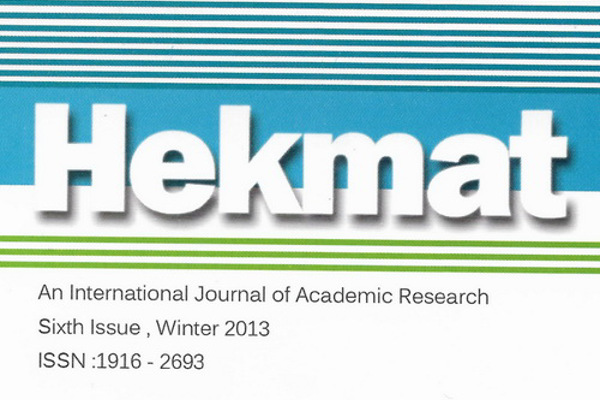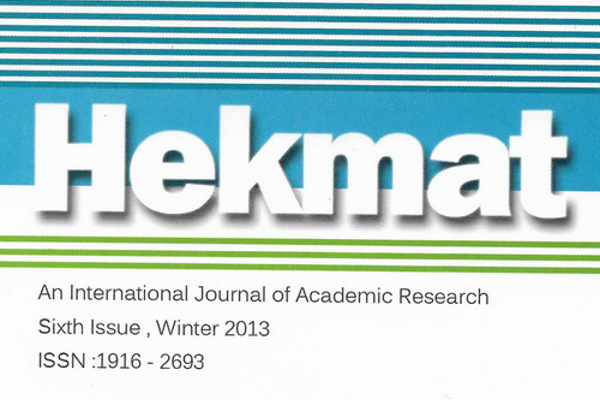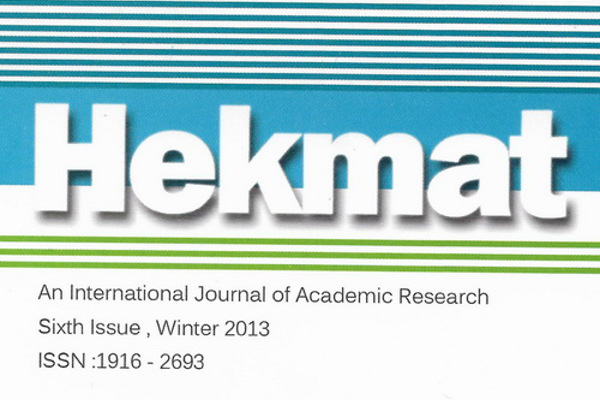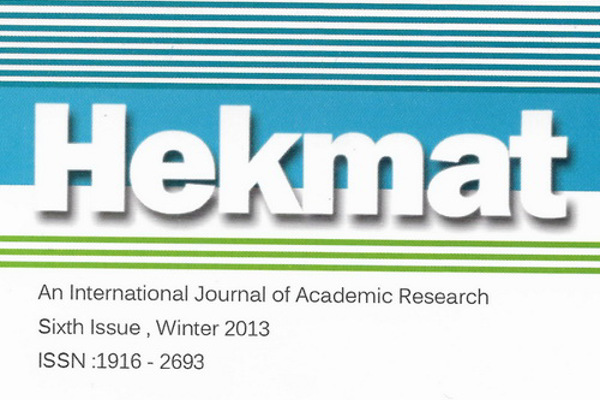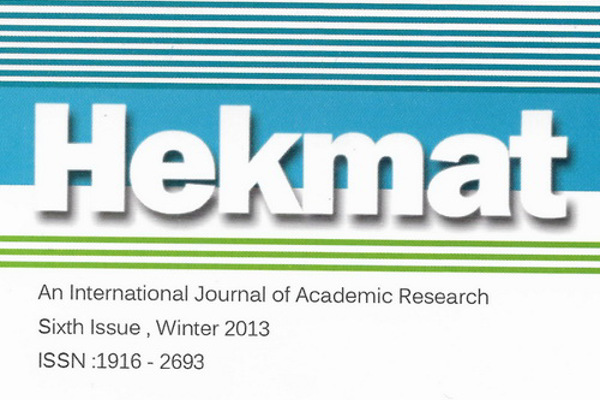Religions and Environment / By: Mohsen Karizi
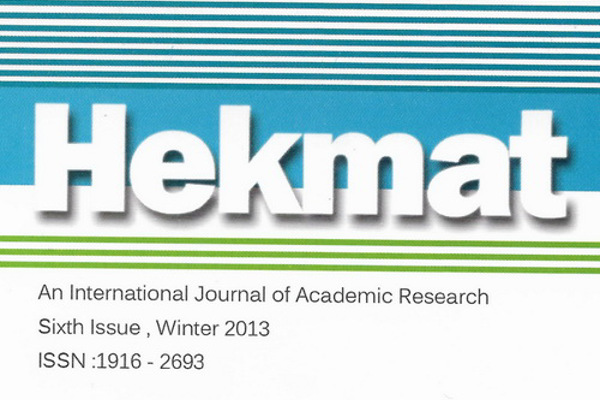
Religions and Environment
By: Mohsen Karizi
It is now more than three decades that experts in environment and experts in religion have carried out valuable researches about the relation between religion and environment. The best and more complete works in this field will be discussed here. We shall steady in this article research works on world religions and their teachings about the environment. Directors of this project aim to start a new project in religion studies that can help improve contemporary ecological ethics.
The works we shall study here or the results of research carried out in the center for world religions studies affiliated to Harvard University during the years 1996 to 1998. This project was headed by Mary Tucker[1] and john Grim[2] and joined by a group of specialists. Over 600 researchers, express in ecology and religious leaders vault over contributed to this huge project. Several conferences were held in which the results of these researches were introduced to public. Harvard University is collaboration of Becknell University and the American Center for Research of life and Environment of human Society of the United States[3]. In the series of the books titled world religions and environment nine great religions of the world have been a steadied. We introduce this series in the order of publication date.
1. Buddhism and environment (coordination with deeds)[4]
This book was published in 1997 its editors in chief are Mary Evelyn Tucker and Duncan Williams[5]. The book has 509 pages. Introducing the book it writes: “bearing in mind present ecological crises and the challenges they pose it is worthwhile to notice that teachings of Buddhist religion concerning the internal relations among all sorts and forms of life can help us reestablish a logical reciprocal relation between man and nature. 20 experts in ecology and religion investigate the views Buddhism holds about the complex net of life. To emphasize on traditional aspects of Buddhism, in their view, helps in framing and efficient and useful ecological morality. The authors mention some of the projects the Buddhists undertook in Asia and the United States in order to preserve the environment. The book includes the following chapters. Chapter one, general survey and classification of subject matters; chapter two, Buddhism and environment: the Thailand case; chapter three, Buddhism and environment the case of Japan; chapter four, Buddhism and animal life in India and Japan; chapter five, Zen Buddhism, problems and the future perspective; chapter six American Buddhism: the formation of ecological societies; chapter seven, the functions of Buddhist ecological views; and finally the eighth chapter on theoretical and methodological he issues in Buddhism.
2. Confucianism and environment (relationship between heaven, the earth and man)[6]
This book is published in 1998 in 420 pages to editors and chief of the Bork of Mary Evelyn Tucker and john. H. Biathlon[7]. The main chapters of this work includes: 1. the nature of criticism[8]. 2. The ground for a reply[9]. 3. Rational resources from China, Korea and Japan. 4. philosophical speculations. 5. from theory to practice.
A critic has said about this book that the book is very valuable. Confucianism is a very rich and efficient resource for framing an ecological outlook. Unfortunately, it’s been neglected. But it should be attended to as much as Buddhism and other American native religions are in intercultural discussions and ecological debates.
3. Christianity and environment (in search of prosperity for the earth and humanity)[10]
This book was published in the year 2000 in 720 pages. It was supervised by Dieter D., Hassel[11] and Rosemary Radford [12]jointly. It includes the following chapters: chapter one: father, son and Holy Ghost from ecological point of view. Chapter two: vision, human mission and virtues for terrestrial society. Chapter three: general and particular issues in ethics and spirituality. Chapter four: towards world security and stability. Chapter five: Christian tradition in the service of environment and justice.
What service can Christian traditions render to the future prosperity of the earth? As a greenhouse effect increases, the storms become more devastating, the stability diminishes and the population grows and distances further from justice, more Christian theologians and expert in Christian morality come to focus on ecological crises. This book advocates a fresh outlook to Christian theology and calls for the collective enterprise of rebuilding the environment on the basis of an ethics centered on ecological justice. Authors of the book come from different walks of life and belongs to Orthodox, Protestant and catholic faiths. They disclose controversial subject matters that led to negligence of environment or its misuse. They try to introduce alternative views that can contribute positively to guarantying ecological justice and responsible social life.
4. Environment and Hinduism (interaction of the heaven and earth and water)[13]
This book was published in the year 2006 in 656 pages under the supervision of Christopher Chappell[14] and Mary Evelyn Tucker. This book deals with the multilayered tradition of Hinduism in the advancement of ecological awareness in India. The authors try to find an answer the question how traditional concepts relevant to nature in classic texts could inspire her friend relation between environment and modern Hindus and how they can play the role of obstacle. The book relates views held by some laymen in India about preservation of environment. The main topics of the book are as follows: 1. the cultural foundations of Hindu traditional concepts of nature. 2. Gandhi’s philosophy and the emergence of an ecological ethics with Indian blend. 3. Jungles in classical traditions and texts. 4. the present sacredness and risking profanity[15]; Yamuna[16] river, Ganga[17] river and Narmada[18] river. 5. Can Hindu texts and religious practices continued to the promotion of ecological awareness?
5. Indigenous tradition: the Interbeing of cosmos and community[19]
This book was published by john green in 2001 in 824 pages. The authors who contributed to the compilation of the book include a number of indigenous American researchers and a number of scientists and environment activists. They focus on some very important issues indigenous Americans are faced with such as the threats to their domain and how to resist it, globalization of the market, media and protection of the animals on the verge of extinction. The book introduces the reader to the sublime humanitarian values indigenous Americans hold in the relation to environment and discusses the creative forms of their resistance against the aforementioned threats in globalization age.
The main chapters of this work are: 1. scattered communities, 2. complex cosmologies, 3. Firm ideologies, 4. resistance and renascence, 5. liberating environments.
6. Daoism and Ecology; ways within a Cosmic Landscape[20]
This book was published in 2001 in 476 pages under the supervision of James Miller[21], N., J., Gerardo [22]and Liu Xiangtan[23]. The writers of this book try to examine possible interactions between Daoism and environment through estimating historical and theoretical characteristics of this religion’s approach to the environment. Also they tried to analyze religious texts belonging to this religion and the influence on Chinese culture.
7. Jainism and ecology; nonviolence[24] in the web of life[25]
This book was published in 2002 in 304 pages by Christopher Chappell. Jainism is a very old religion. It dates back to over 2500 years. This religion emphasizes on nonviolence as the only way for human prosperity. The outlook towards the world this religion introduces seems to be consistent with activities aiming the preservation of environment. But the question is: can Jainism contribute to the establishment of community based environmentism in spite of the severe mortification spirit that the spiritual tradition of this religion is based on?
8. Judaism and ecology: created world and revealed word[26]
This book was published in 2002 in 620 pages by Hava Tirosh Samuelson[27]. The ecological discourse of Judaism clearly indicates that this religion has a deep concern for comfort and prosperity in the natural world. The book tries to elucidate the different concepts of nature in Jewish thought in order to pave the way for the emergence of a new Jewish ecological discourse that reforms Jewish theology. 29 people have contributed to the authorship of the book. They have focused on the Old Testament and the rabbinic literature[28] investigating the relation between the story of creation and the theory of revelation so far as natural rules are concerned. They have also evaluated the themes relating nature to ethics. These writers challenge the secular ecological discourse from the point of view of the Jewish mystical tradition and religious orders.
9. Islam and environment a Bestowed Truth[29]
This is the last volume of the series. It is published in 2003 under the supervision of Richard Foltz[30], Frederick Denny[31] of and Azizan Baharuddin[32]. It has 584 pages.
Muslims with a population of 1.5 billion people comprise almost a fish one sixth of the population of the world. Ordinary people in the west imagine that Islam means Mediterranean and Arab world. However we should bear in mind that around 75% of Muslims live in the Asian Far East around 350 million of which live in Bangladesh, India and Pakistan. Indonesia is a country with the biggest Muslim population. There are Muslim minorities in countries like Finland, Equator and New Zeeland. Most of western countries too host considerable a number of Muslims. Some believe that Islam has grown in the United States of America more than elsewhere and more than any other religion in recent decades. Like Christianity and Judaism, Islam is a monotheistic religion. Quran is the holy book of this faith. It is the axis of the faith of Muslims. Along with sayings of the prophet of Islam and those of his vicegerents the immaculate Imams, their behavior and style of life are considered religious sources next to the text of Quran. In these religious sources Muslims are reminded of valuable resources of life like climate and soil and are instructed to utilize them with responsibility and avoid extravagance and wasting. Sayings of the prophet of Islam and immaculate imams obviously indicate their concern for the presentation of natural resources and their just distribution among people. From the advent of Islam, this religion has taught his followers elementary principals of understanding ecology and persuaded them to observe these principles in order to become capable of the rank of God’s viceroy on the planet earth.
However, ecological ethics in its modern concept is a new phenomenon. The first Muslim philosopher who took up this issue is the Iranian Shiite scholar Professor Hussein Nasr who wrote the book “philosopia prennis” with the collaboration of Frithjof Schuon[33] and Titus Burckhardt[34] and Rene Guenon[35]. In this book the authors defend the idea that eternal truths are elucidated in some philosophical, cultural and historical traditions. Criticisms of the western world began in the works of Nasr with the series of lectures he delivered in Chicago university in 1966 to be published one year later under the title “man and nature”.
The conference entitled “Islam and ecology” was organized in May 1998 in the center for World religions studies affiliated to Harvard University by john Grim, Fazlun Khalid[36] and Mary Tucker in three days. The papers and presentations of this conference are included in the book Islam and ecology we are now describing. Several other conferences in the Islamic world were held late on to follow this topic. Tehran conference and Jeddah conference were organized by governments. Some of the papers read that these conferences are published in this book.
According to Muslim thinkers, the present ecological crisis is only a sign of a far graver calamity that has befallen humanity that is further distancing of man from the style of life that God approves. If society is based on justice relations among men and their relationship with God are so established that ecological problems will not easily strike it.
This book is arranged in five chapters. Chapter one discusses God man and nature. Chapter two is about the challenge of reinterpretation. Chapter three discusses environment and social justice. Chapter four is titled: towards a sustainable society. And the title of the fifth chapter reads: Islamic Garden as a metaphor of paradise.
The first chapter; on God man and nature introduces the Islamic vision of the cosmological order and includes the following papers:
Paper one is titled” Lanning ecological ethics according to Quran”. It is written by Ibrahim Ozdemir[37]. It focuses on Quran and tries to explain Islamic view on man’s place in the hierarchy of existence. The writer compares the modern interpretations of Quran with traditional ones and concludes that understanding the relation between God the creator, human beings and other creatures from the Quran perspective helps us find in this heavenly book the fundamentals of ecological ethics as Islam envisages.
Paper two bears the title “the living world of nature in Mathnawi of Jalaloddean Rumy” and is written by L., Clark[38]. The writer explains the cosmology found in the mystical poems composed by Rumi. According to Rumi, the whole world is alive and human beings are but one port of divine creation in which all beings are occupied in eulogy to God. Some lines of poetry by Rumi that contain this notion are as follows:
Wind, soil, water and fire are all servants;
Dead in my eyes and in yours but alive with God;
Human beings deny that inanimate objects eulogize God;
Yet, those objects know well how to warship God;
Water, soil and clay and well speak though;
Only the sense organs of the mystics can catch their speech.
The third paper titled “human natural disposition as the Islamic model for environments and humanity” is written by Sadyyeh Khavarkhan[39]. This paper suggests that the Islamic concept of fitrat i.e. Human natural disposition can be taken as the basis of a new ecological interpretation of the world in which everything is seen to have an eternal immutable essence with primordial relations it has to bear to other beings. From this point of view, human nature is said to be in harmony with the nature of all those things that exist around him. Ecological conscience is, consequently, inbuilt in every individual. It has to be only awakened. People need not be educated in this field because they do already know. It suffices to remind them.
The second part; includes articles aiming to find an answer to the question how the contemporary Islamic world view can be employed for overcoming the present ecological challenges. The first paper in this part is written by Dr. Seyyed Hussein Nasr under the title” Islam, contemporary Islamic world and ecological crises”. The writer points to the variety of obstacles hindering the realization of Islamic ecological ethics in the present world and gives hints to their solutions.
The second paper is written by Mawil Izzi Dien[40] who is among few Muslim thinkers who speak about ecological issues as problems of high importance. His paper is titled” Islam and ecology; theory and practice” examines problems like the shortage of water, water pollution and other crises Islamic world is now facing.
The third paper is written by Numanul Haq[41] under the title” is them and environment; the form and reconstruction”. In this paper of the writer consults the Islamic original resources including Quran, hadeeth and Islamic Sharia in an effort to find out how traditional Islam can guide Muslims in their struggle with ecological problems.
The fourth paper is written jointly by Abdul Aziz Said[42] and Nathan Funk[43] about the ecological reading of Islamic traditional concepts such as monotheism and peace. The writers believe that present ecological problems emerge in the first place as a result of neglecting the genuine meaning of “Islam” which is intended to overlooking monotheism.
The fifth paper is by Othman Abdorrahman Liewellyn[44] carrying the title “a basis for inventing the department of Islamic ecological rights”. In this paper, the writer casts a comprehensive look at the way Islamic traditional Sharia deals with ecological issues and management. He points out that the majority of the laws of Sharia are not implemented in the majority of Muslim countries. He proposes a set of solutions for this problem hinting at modern interpretation of these rules and proper methods for the enforcement.
The sixth paper is written by Richard Foltz[45] with the Title: “Islamic environmentism; a subject matter worthwhile to study”. This paper tries to show how the transition from theory to practice has taken place in the Islamic Republic of Iran through the translation of Islamic principles concerning environment preservation into legislation and procedures both on governmental and public levels.
The seventh paper is written by Kaveh Afrasiabi under the title” Towards ecological theology of Islam”. They write a believes that Islam does enjoy outstanding sources so for as respected environment is concerned yet Muslim thinkers ought to take some further steps to review some of their presuppositions if they expect to appear efficient and capable of presenting actual solutions for the existing crises.
Papers of the third part; The first paper by Fazlun Khalid[46] is about” environment and social justice”. It explores the roots of the present ecological crises in the world and blames the western modernity imposed on the Muslim Communities and societies in the last few centuries as the main cause.
The second paper is written by Yasin Dutton[47] under the title “the ecological crisis of our time and the Islamic answer”. This paper examines some aspects of the modern world such as the world banking system and blames the spirit of interest seeking as a foundation of the system for the source of unquenchable thirst for wealth that can lead to the destruction of human society.
The third paper is written by Hashem Ismal Dockrat[48] under the title “Islam Islamic Society and ecological concerns”. In this paper he explains why a theoretically modern Islamic regime is superior to present regime.
The fourth paper is by Nawal Ammar[49] with the title “ecological justice and human rights of women in Islam”. In this paper, the writer combines the eco-feministic [50] criticism with an evaluation of the Islamic social justice and concludes that ecological issues should be studied in a broader framework that guarantees women’s right to equal access to natural and social resources.
The fourth part; towards a sustainable society; The first article in this part is by Mohammad Aslam Parviz[51] under the title “Almizan and Scientific innovation”. The article analyzes the Quran concept mizan or balance. Citing several motels found in contemporary societies, the writer indicates how this Quranic principle has been overlooked.
The second paper is written by Safioddin Hamed[52] with the title” making sustainable development possible; the case of Islamization of ecological institutions”. The author examines in this paper the phenomenon of development in contemporary Islamic societies from a wider point of view. Branding some authors’ vision of 100% Islamized models of development has rather wishful thinking; he questions the efficiency of such models in practice.
The third article is written jointly by Nancy Jabbra[53] and Joseph Jabbra[54]. This article examines some cases of family control programs in Islamic countries like Egypt and Iran under the title” Islam, environment and family control programs the two cases of Egypt and Iran”.
The fourth article was written by Mohammed Usof Sadiq[55] with the title” an ecological trip to Islamic Bangladesh”. This article examines the experience of Bangladesh has one of the poorest countries of the world and the most populated in the Islamic world. The article concludes that preservation of environment cannot be addressed independently from the question of poverty. Any plan for protection of environment must also succeed in eradication of poverty.
“Islam in the theory of development and planning in Malaysia” is the fifth paper written by Abubakr Abdolmajid[56]. The writer believes that the foundational principals of developers in Malaysia cohere with Islamic definitions of social justice. Malaysian program for development is named” the prospect of the year 2020”.
The last article in this chapter by Tazim Kassam[57] his” Agha Khan Development net; the morality of sustainable development and social awareness”. This article explains projects founded by Agha Khan Foundation.
Chapter five; The first article in this chapter is titled” nature in Islamic city; real garden and virtual garden”. This article was written by Attillio Pettuccioli[58] who studies various methods through which Islamic traditional society tried to retain his position in the order of nature via architecture and construction of gardens.
The second article is written by James Westcott[59] under the title” from Quran’s paradises to the gardens of Lahore”. Examples of royal gardens during Mongol empire in the city of Lahore in Pakistan during 17th century are examined.
Farzaneh Milani studies the metaphor of garden in the plans of the contemporary celebrated feminist’s poet Forugh Farrokhzad in her article titled” trees as ancestors: eco-feminism and the poetry of Forugh Farrokhzad”.
It is worthwhile to mention him that the research we just described has unfortunately has overlooked Zoroastrian religion entirely. This is quite surprising. Because there are valuable references in the religious texts of this faith to questions of environment we are not concerned with. We should mention some of them here in brief. According to the teachings of Zoroaster in the grand book Avesta but is also the oldest written document of ancient Iran, soil is the mother of life and the foundation of all forms of life on this planet. Avesta speaks about the ever current cycle of death and birth which all living beings undergo named “the cycle of life”. It is by means of this cycle that the energy of life penetrates from the soil into the body of a plant and from there to the body of an animal and after a while, returns back to the soil. There is a prayer in Avesta especially for the mother of life. There is another prayer parallel to the previous one for water because water as a cadre of life is no less important and the soil. Soil becomes fertile only with the help of water. The third prayer in Avesta is eulogy to the sun the father of life and the greatest source of energy without which life would have been impossible on this planet. The next prayer eulogizes the breezing of life i.e. e. air: “where there is breathing there is life, where there is life there is breathing, so breathing is the very life”. Another prayer is eulogy to “the fire of life”. The phrase fire of life is a metaphor for the living force. When Avesta says:” build the fires of life with clean wood”, he means one should keep the living currents in one’s body moving with the help of proper and appropriate food alone. In this religion fire is the symbol of purity. When talking about human spirituality, fire means purity of the soul in the same way that the force of life refers to the purity of body.
Another prayer in Avesta is “brother tree”. According to Zoroaster, human beings and trees are like brothers of one another. They cannot properly live unless they cooperate. Based on these teachings every father ought to plant a tree when his child is born as soon as possible in memory of the birth. In every birthday the father of two plants another tree and the garden which is build in this way would be later given to the son or daughter has a gift. Man is as much a part of nature as animals and plants are though it is man who is the vicegerent of God on the earth who is this charged with the task of working and constructing under the light of the three holy laws: good deeds, good speech and good thought.
Reflecting on the genuine meanings of this simple religion we would realize that the teachings of Zoroaster connect human life to this world in such a manner that all human activities become interwoven with the forces of nature. This is the secret why the holy book of this region is called Avesta meaning the book of life[60].
Introduction to the chief editors of the books
- Buddhism: Mary Evelyn Tucker, the professor of Bucknel University and researcher in religion. She is one of the coeditors of the book world views and ecology and the book Buddhism and ecology. Duncan Williams is an expert in the religious history of Japan. He teaches in Harvard University.
- Confucianism: john bartering is an assistant professor at the school of divinity in Boston University. He works in the field of academic and administrative affairs.
- Christianity: Dieter Hassel is the direction of the project ecology, justice and faith. He is also the deputy director of the department” divinity education and training for meeting the ecological challenges. Rosemary Radford teaches divinity and the faculty of Anglican divinity now faculty Garret.
- Hinduism: Christopher Chappell is the professor of Loyola Marymount University in theological studies and the director of research about Asia on Pacifist Ocean.
- Indigenous American religions: john Grim is a professor of religious studies in the university of Leicester he is the author of the book “shaman; examples of healing in Siberia and Ojibwa”. If he's also one of the ad tools of the book world views and environment.
- Daoism: N., J., Gerardo Ismail the standing profile so home for university of Lehigh in the field of religious studies. James Mill is and researcher in this religion at queen university. Liu Xiangtan as a professor of the National University of Singapore.
- Judaism: HavaTirosh Samuelson is an assistant professor of history in the state university of Arizona
- Islam: Richard Foltz is the system professor in the founder of religious studies natural resources history and Asian studies in Florida University. Frederick Denny is a professor of religious studies in Colorado University in Boulder. Azizan Baharoddin is a director of the center for dialogue among civilizations and university of Malaya in Kuala Lumpur.
[1]. World religions and ecology.
[2]. Anthropocentric.
[3]. Mary Evelyn tucker.
[4]. john Grim.
[5]. Center for respect of life and environment of human society of United States.
[6]. Buddhism and ecology the connection of dharma and deeds.
[7]. Duncan Williams.
[8]. Confucianism and ecology the interrelation of heavens, earth and humans.
[9]. John Berthrong.
[10]. the nature of critique.
[11]. the context for response.
[12]. Christianity and ecology, seeking well being of the Earth and Humans.
[13]. Dieter Hassel.
[14]. Rosemary Radford.
[15]. Hinduism and ecology; the intersection of the earth, sky and water.
[16]. Christopher Chappell.
[17]. flowing Sacratity and risking profanity.
[18]. Yamuna.
[19]. Gang.
[20]. Narmada.
[21]. indigenous tradition; the interbeing of cosmos and community.
[22]. Daoism and ecology: ways within the cosmic landscape.
[23]. Liu Xiangtan.
[24]. James Miller.
[25]. N., J., Gerardo.
[26]. nonviolence.
[27]. Jainism and ecology nonviolence in the web of life.
[28]. Judaism and ecology created world and revealed word.
[29]. Hava Tirosh s Samuelsson.
[30]. Rabbinic.
[31]. Islam and ecology; a bestowed truth.
[32]. Richard Foltz.
[33]. Frederick Denny.
[34]. Azizan Baharuddin.
[35]. Frithjof Schuon.
[36]. Titus Burchhardt.
[37]. Rene Guenon.
[38]. Faziun Khalid.
[39]. Ibrahim Ozdemir is a professor of history of philosophy in Ankara University and the author of books such as the more aspects of human approach to nature. He has also published a number of papers.
[40]. Clarke is a PHD graduate from McGill university’s Center for Islamic studies in Canada. Among his works are “to rise and fall of taqiyeh in Shiesm” “Mystical Thought in Islam”.
[41]. Sadia Khawar Khan Chishti is a PHD graduate of education from Cornell University in U.S.... He is one of the co-writers of the Bork “the encyclopedic history of universal spirituality”.
[42]. Mawii Izzi Dian.
[43]. Numanul Haq is a researcher in the field of the history of Islamic enlightenment, mysticism and religion. He's a lecture in Pennsylvania University.
[44]. Abdolaziz Said is a professor in the school of International Services of the American University and the author of the book international political concepts from global perspective.
[45]. Nathan Funk is a lecturer of political sciences in Washington university and one of the co-writers of the book the problem of peace and war in Islam.
[46]. Othman Abdurrahman Lieweliyn is one of the planners in the field of environment in Saudi Arabia and a member of the world commission for preserved regions.
[47]. Fazlun Khalid is a founder of the Islamic Center for ecology and one of the co-writers of the book Quran creation and protection of environment.
[48]. Yasin Dutton has studied in oxford Christian college and written several papers and books such as principals of Islamic Sharia.
[49]. Hashim Ismall Dokrat is the founder and director of the institute for human development and environment. He has published a book founding free society in 1996.
[50]. Nawal Ammar is the assistance professor of the state University of Kent in USA. He works in the field of studies about justice, anthropology, women and justice, immigrant women's and prisoners.
[51]. eco-feminism.
[52]. Muhammad Aslam Parviz is a professor of Delhi university and the director of the Islamic scientific foundation for sciences and ecology.
[53]. A. Hamed is a consultant of ecological planning and a researcher in the field of international development in North America and Mediterranean region.
[54]. Nancy Jabbra is an anthropologist, university professor and the direction of the center for women studies at Marymount University and author of the book ecological challenges.
[55]. Joseph Jabbra is the professor of political science is in Marymount University of Los Angeles. His last work is “where is corruption?”
[56]. Muhammad Seddiq is university professor in the United Emirates. He’s the author of several articles in the encyclopedia of Islam.
[57]. Abubakr Abdolmajid works as a professor in the faculty of pharmacy in Mara university of Malaysia. Among his works are “Bio ethics”, “Faith and Science”, “the Earth and the Sky” and others.
[58]. Tazim Kassam is the assistant professor of Islamic studies in university and the author of the book” the songs of wisdom and the circles of Semaa”.
[59]. Attillo Pettuccioli is a professor of Islamic architecture in MIT University and a founder of the center for Islamic ecological studies in the year 1980.
[60]. Wescoat is a professor of architecture Illinois University and the divisor in the project of preservation of Taj Mahal monument in India.


